Agkistrodon contortrix
Agkistrodon contortrix is a species of venomous snake, a pit viper, endemic to Eastern North America; it is a member of the subfamily Crotalinae in the family Viperidae. The common name for this species is the eastern copperhead.[3] The generic name is derived from the Greek words ancistro (hooked) and odon (tooth), or fishhook.[4] The trivial name, or specific epithet, comes from the Latin contortus (twisted, intricate, complex); which is usually interpreted to reference the distorted pattern of darker bands across the snakes back, which are broad at the lateral base but "pinched" into narrow hourglass shapes in the middle at the vertebral area.[5][6] Five subspecies have been recognized in the past,[7] but recent genetic analysis shows that A. contortrix and two of the subspecies are monotypic, while Agkistrodon laticinctus (formerly Agkistrodon contortrix laticinctus) and the fifth subspecies are a single distinct species (see subspecies table below).
| Agkistrodon contortrix | |
|---|---|
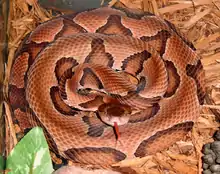 | |
| Scientific classification | |
| Kingdom: | Animalia |
| Phylum: | Chordata |
| Class: | Reptilia |
| Order: | Squamata |
| Suborder: | Serpentes |
| Family: | Viperidae |
| Genus: | Agkistrodon |
| Species: | A. contortrix |
| Binomial name | |
| Agkistrodon contortrix (Linnaeus, 1766) | |
 | |
| Synonyms[2] | |
| |
It is a common species in many areas within its range, which may lead to accidental encounters with humans.
Description

Adults grow to a typical length (including tail) of 50–95 cm (20–37 in). Some may exceed 1 m (3.3 ft), although that is exceptional for this species.[8] Males are usually larger than females. Good-sized adult males usually do not exceed 74 to 76 cm (29 to 30 in), and females typically do not exceed 60 to 66 cm (24 to 26 in).[9][10] In one study, males were found to weigh from 101.5 to 343 g (3.58 to 12.10 oz), with a mean of roughly 197.4 g (6.96 oz).[11] According to a different study, females have a mean body mass of 119.8 g (4.23 oz).[12] The maximum length reported for this species is 134.6 cm (53.0 in) for A. c. mokasen (Ditmars, 1931). Brimley (1944) mentions a specimen of A. c. mokasen from Chapel Hill, North Carolina, that was "four feet, six inches" (137.2 cm), but this may have been an approximation. The maximum length for A. c. contortrix is 132.1 cm (52.0 in) (Conant, 1958).[5]
The body is relatively stout and the head is broad and distinct from the neck. Because the snout slopes down and back, it appears less blunt than that of the cottonmouth, A. piscivorus. Consequently, the top of the head extends further forward than the mouth.[13]
The scalation includes 21–25 (usually 23) rows of dorsal scales at midbody, 138–157 ventral scales in both sexes and 38–62 and 37–57 subcaudal scales in males and females, respectively. The subcaudals are usually single, but the percentage thereof decreases clinally from the northeast, where about 80% are undivided, to the southwest of the geographic range where as little as 50% may be undivided. On the head are usually 9 large symmetrical plates, 6–10 (usually 8) supralabial scales, and 8–13 (usually 10) sublabial scales.[5]
The color pattern consists of a pale tan to pinkish-tan ground color that becomes darker towards the foreline, overlaid with a series of 10–18 (13.4) crossbands. Characteristically, both the ground color and crossband pattern are pale in A. c. contortrix. These crossbands are light tan to pinkish-tan to pale brown in the center, but darker towards the edges. They are about two scales wide or less at the midline of the back, but expand to a width of 6–10 scales on the sides of the body. They do not extend down to the ventral scales. Often, the crossbands are divided at the midline and alternate on either side of the body, with some individuals even having more half bands than complete ones. A series of dark brown spots is also present on the flanks, next to the belly, and are largest and darkest in the spaces between the crossbands.
The belly is the same color as the ground color, but may be a little whitish in part. At the base of the tail are one to three (usually two) brown crossbands followed by a gray area. In juveniles, the pattern on the tail is more distinct: 7–9 crossbands are visible, while the tip is yellow. On the head, the crown is usually unmarked, except for a pair of small dark spots, one near the midline of each parietal scale. A faint postocular stripe is also present; diffuse above and bordered below by a narrow brown edge.[13]
Several aberrant color patterns for A. c. contortrix, or populations that intergrade with it, have also been reported. In a specimen described by Livezey (1949) from Walker County, Texas, 11 of 17 crossbands were not joined middorsally, while on one side, three of the crossbands were fused together longitudinally to form a continuous, undulating band, surmounted above by a dark stripe that was 2.0–2.5 scales wide.
In another specimen, from Lowndes County, Alabama, the first three crossbands were complete, followed by a dark stripe that ran down either side of the body, with points of pigment reaching up to the midline in six places, but never getting there, after which the last four crossbands on the tail were also complete. A specimen found in Terrebonne Parish, Louisiana, by Ernest A. Liner, had a similar striped pattern, with only the first and last two crossbands being normal.[13]
Common names
Common names for A. contortrix include: copperhead (snake), chunk head, highland moccasin, (dry-land) moccasin, narrow-banded copperhead, northern copperhead, pilot snake, poplar leaf, red oak, red snake, southeastern copperhead, white oak snake,[14] American copperhead,[15] southern copperhead,[13] and cantil cobrizo (Spanish).[7]
Distribution and habitat
It is found in North America; its range within the United States is in Alabama, Arkansas, Connecticut, Delaware, Florida, Georgia, Illinois, Indiana, Iowa, Kansas, Kentucky, Louisiana, Maryland, Massachusetts, Mississippi, Missouri, Nebraska, New Jersey, New York, North Carolina, Ohio, Oklahoma, Pennsylvania, South Carolina, Tennessee, Texas, Virginia and West Virginia. In Mexico, it occurs in Chihuahua and Coahuila. The type locality is "Carolina". Schmidt (1953) proposed the type locality be restricted to "Charleston, South Carolina".[2]
Unlike some other species of North American pit vipers, such as the timber rattlesnake and Sistrurus catenatus, A. contortrix has mostly not re-established itself north of the terminal moraine after the last glacial period (the Wisconsin glaciation),[16] though it is found in southeastern New York and southern New England, north of the Wisconsin glaciation terminal moraine on Long Island.
Within its range, it occupies a variety of different habitats. In most of North America, it favors deciduous forest and mixed woodlands. It is often associated with rock outcroppings and ledges, but is also found in low-lying, swampy regions. During the winter, it hibernates in dens or limestone crevices, often together with timber rattlesnakes and black rat snakes.[17] In the states around the Gulf of Mexico, however, this species is also found in coniferous forest. In the Chihuahuan Desert of West Texas and northern Mexico, it occurs in riparian habitats, usually near permanent or semipermanent water and sometimes in dry arroyos (brooks).[5]
Conservation status
This species is classified as least concern on the IUCN Red List of Threatened Species (v3.1, 2001).[1] This means that relative to many other species, it is not at risk of extinction in the near future. The population trend was stable when assessed in 2007.[18]
Behavior
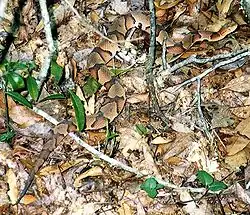
Like all pit vipers, A. contortrix is generally an ambush predator; it takes up a promising position and waits for suitable prey to arrive. One exception to ambush foraging occurs when copperheads feed on insects such as caterpillars and freshly molted cicadas. When hunting insects, copperheads actively pursue their prey.[19] Juveniles use a brightly colored tail to attract frogs and perhaps lizards, a behavior termed caudal luring (see video: ). In the Southern United States, they are nocturnal during the hot summer, but are commonly active during the day during the spring and fall.
Unlike other viperids, they often "freeze" instead of slithering away, and as a result, many bites occur due to people unknowingly stepping on or near them.[20] This tendency to freeze most likely evolved because of the extreme effectiveness of their camouflage. When lying on dead leaves or red clay, they can be almost impossible to notice. They frequently stay still even when approached closely, and generally strike only if physical contact is made. Like most other New World vipers, copperheads exhibit defensive tail vibration behavior when closely approached. This species is capable of vibrating its tail in excess of 40 times per second— faster than almost any other non-rattlesnake snake species.[21]
Feeding
Roughly 90% of its diet consists of small rodents, such as mice and voles. It has also shown fondness for large insects and frogs, and though highly terrestrial, has been known to climb trees to gorge on emerging cicadas. Copperhead populations may be reduced by non-venomous Eastern King Snakes Lampropeltis getula that feed on venomous copperheads.
Reproduction
Agkistrodon contortrix breeds in late summer, but not every year; sometimes females produce young for several years running, then do not breed at all for a time. They give birth to live young, each of which is about 20 cm (7.9 in) in total length. The typical litter size is four to seven, but as few as one, or as many as 20 may be seen. Their size apart, the young are similar to the adults, but lighter in color, and with a yellowish-green-marked tip to the tail, which is used to lure lizards and frogs.
Agkistrodon contortrix males have longer tongue tie lengths than females during the breeding season, which may aid in chemoreception of males searching for females.[22]
Facultative parthenogenesis
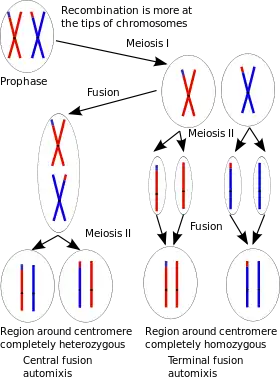
Parthenogenesis is a natural form of reproduction in which growth and development of embryos occur without fertilization. A. contortrix can reproduce by facultative parthenogenesis, that is, they are capable of switching from a sexual mode of reproduction to an asexual mode.[23] The type of parthenogenesis that likely occurs is automixis with terminal fusion, a process in which two terminal products from the same meiosis fuse to form a diploid zygote. This process leads to genome-wide homozygosity, expression of deleterious recessive alleles, and often to developmental failure (inbreeding depression). Both captive-born and wild-born A. contortrix snakes appear to be capable of this form of parthenogenesis.[23]
Venom
Although venomous, these snakes are generally not aggressive and bites are rarely fatal. Copperhead venom has an estimated lethal dose around 100 mg, and tests on mice show its potency is among the lowest of all pit vipers, and slightly weaker than that of its close relative, the cottonmouth. Copperheads often employ a "warning bite" when stepped on or agitated and inject a relatively small amount of venom, if any at all. "Dry bites" involving no venom are particularly common with the copperhead, though all pit vipers are capable of a dry bite.
Bite symptoms include extreme pain, tingling, throbbing, swelling, and severe nausea. Damage can occur to muscle and bone tissue, especially when the bite occurs in the outer extremities such as the hands and feet, areas in which a large muscle mass is not available to absorb the venom. A bite from any venomous snake should be taken very seriously and immediate medical attention sought, as an allergic reaction and secondary infection are always possible.
The venom of the southern copperhead has been found to hold a protein called "contortrostatin" that halts the growth of cancer cells in mice and also stops the migration of the tumors to other sites.[24] However, this is an animal model, and further testing is required to verify safety and efficacy in humans.[25]
The antivenom CroFab is used to treat copperhead envenomations that demonstrate localized or systemic reactions to the venom. As many copperhead bites can be dry (no envenomation), CroFab is not given in the absence of a reaction (such as swelling) due to the risk of complications of an allergic reaction to the treatment.[26] The antivenom can cause an immune reaction called serum sickness. Pain management, tetanus immunization, laboratory evaluation, and medical supervision in the case of complications are additional courses of action.[27] In 2002, an Illinois poison control center report on the availability of antivenom stated it used 1 Acp to 5 Acp depending on the symptoms and circumstances.
Subspecies
A. contortrix was long considered to contain five subspecies listed below. However, gene analysis suggests that A. c. laticinctus represents its own distinct species, while mokasen and phaeogaster are regional variants of contortrix, and pictigaster a regional variant of laticinctus.[28]
| Previous taxonomy[7][13] | Current taxonomy[28] | Geographic range[28] |
|---|---|---|
| Southern copperhead
Agkistrodon contortrix contortrix (Linnaeus, 1766) |
Eastern copperhead
Agkistrodon contortrix (Linnaeus, 1766) |
The United States: east Texas, east Oklahoma, extreme eastern Kansas, and extreme southeastern Nebraska, eastward to the Atlantic coast; north to extreme southeast Iowa, southern Illinois, southern Indiana, southern Ohio, Pennsylvania, southeast New York, Massachusetts, and parts of Connecticut; absent from southern Georgia and the Florida Peninsula. |
| Broad-banded copperhead | Broad-banded copperhead
Agkistrodon laticinctus |
In the United States from eastern Kansas, southwest through central Oklahoma, central and Trans-Pecos, Texas and neighboring areas of northern Chihuahua and Coahuila, Mexico. |
| Northern copperhead
Agkistrodon contortrix mokasen Palisot de Beauvois, 1799 |
Eastern copperhead
Agkistrodon contortrix |
The United States, in southern Illinois, extreme northeastern Mississippi, northern Alabama, northern Georgia northeast to Massachusetts, the Appalachian Mountain region and associated plateaus |
| Osage copperhead
Agkistrodon contortrix phaeogaster Gloyd, 1969 |
Eastern copperhead
Agkistrodon contortrix |
The United States, in eastern Kansas, extreme southeastern Nebraska and a large part of Missouri |
| Trans-Pecos copperhead
Agkistrodon contortrix pictigaster Gloyd & Conant, 1943 |
Broad-banded copperhead
Agkistrodon laticinctus |
The Trans-Pecos region of western Texas and adjacent areas of northern Chihuahua and Coahuila, Mexico. |
Gallery
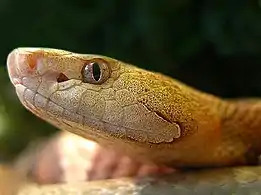 Head of copperhead photographed in Rheinberger Terra-Zoo, Germany.
Head of copperhead photographed in Rheinberger Terra-Zoo, Germany. Eastern copperhead (Agkistrodon contortrix) from Georgetown Co., South Carolina (23 August 2013).
Eastern copperhead (Agkistrodon contortrix) from Georgetown Co., South Carolina (23 August 2013)._photographed_in_Liberty_Co.%252C_Texas._W._L._Farr.jpg.webp) Eastern copperhead (Agkistrodon contortrix) from Liberty Co., Texas (30 March 2007).
Eastern copperhead (Agkistrodon contortrix) from Liberty Co., Texas (30 March 2007)..jpg.webp) A copperhead from Jefferson Co., Missouri with yellow tail typical of juveniles (2 Sept. 2018).
A copperhead from Jefferson Co., Missouri with yellow tail typical of juveniles (2 Sept. 2018)._(16426738014).jpg.webp) Eastern copperhead (Agkistrodon contortrix) Jefferson Co., Missouri (5 April 2015: 67°f) were previously classified as "Osage copperhead" (Agkistrodon contortrix phaeogaster).
Eastern copperhead (Agkistrodon contortrix) Jefferson Co., Missouri (5 April 2015: 67°f) were previously classified as "Osage copperhead" (Agkistrodon contortrix phaeogaster). Eastern copperhead (Agkistrodon contortrix) Westchester County, New York (May 2002). Northern populations, typically darker, were previously classified as A. c. mokasen.
Eastern copperhead (Agkistrodon contortrix) Westchester County, New York (May 2002). Northern populations, typically darker, were previously classified as A. c. mokasen. Eastern copperhead (Agkistrodon contortrix) from Arkansas about to eat a Cicada.
Eastern copperhead (Agkistrodon contortrix) from Arkansas about to eat a Cicada.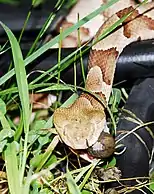 Eastern copperhead (Agkistrodon contortrix) swallowing a Cicada.
Eastern copperhead (Agkistrodon contortrix) swallowing a Cicada.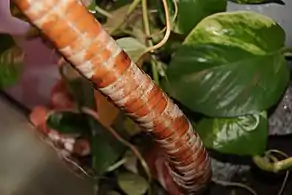 View of the ventral, or belly, pattern of a copperhead.
View of the ventral, or belly, pattern of a copperhead.
References
- Frost DR; Hammerson GA; Santos-Barrera G (2007). "Agkistrodon contortrix". IUCN Red List of Threatened Species. 2007. Retrieved 2017-05-20.
- McDiarmid RW, Campbell JA, Touré T (1999). Snake Species of the World: A Taxonomic and Geographic Reference, Volume 1. Washington, District of Columbia: Herpetologists' League. 511 pp. ISBN 1-893777-00-6 (series). ISBN 1-893777-01-4 (volume).
- Moriarty, John J. 2017. Scientific and standard English names of amphibians and reptiles of North America north of Mexico with comments regarding confidence in our understanding. 8th ed. Society Study Amphibians and Reptles Herpetological Circular 43: 102 pp.
- "Illinois Natural History Survey Agkistrodon contortrix". www.inhs.illinois.edu. Retrieved 2019-07-22.
- Campbell JA, Lamar WW (2004). The Venomous Reptiles of the Western Hemisphere. Ithaca and London: Comstock Publishing Associates. 870 pp., 1,500 plates. ISBN 0-8014-4141-2.
- Lemos Espinal, J. A., G. R. Smith, J. R. Dixon, and A. Cruz. 2015. Amphibians and Reptiles of Sonora, Chihuahua, and Coahuil, Mexico. CONABIO, Mexico D. F. 668 pp. ISBN 978-607-8328-27-7
- "Agkistrodon contortrix ". Integrated Taxonomic Information System. Retrieved 28 November 2006.
- Ernst, Carl H.; Barbour, Roger W. (1989). Snakes of Eastern North America. Fairfax, Virginia: George Mason University Press. 282 pp. ISBN 978-0913969243.
- Palmer, William M.; Braswell, Alvin L. (1995). Reptiles of North Carolina. Chapel Hill and London: University of North Carolina Press. 448 pp. ISBN 978-0807821589.
- Stejneger, L (1895). The Poisonous Snakes of North America. Washington, District of Columbia: United States Government Printing Office.
- Schuett GW; Grober MS (2000). "Post-fight levels of plasma lactate and corticosterone in male copperheads, Agkistrodon contortrix (Serpentes, Viperidae): differences between winners and losers". Physiology & Behavior. 71 (3): 335–341. doi:10.1016/s0031-9384(00)00348-6. PMID 11150566. S2CID 10137506.
- Shine R (1992). "Relative clutch mass and body shape in lizards and snakes: is reproductive investment constrained or optimized?". Evolution 46 (3): 828-833.
- Gloyd HK, Conant R (1990). Snakes of the Agkistrodon Complex: A Monographic Review. Society for the Study of Amphibians and Reptiles. 614 pp., 52 plates. LCCN 89-50342. ISBN 0-916984-20-6.
- Wright AH, Wright AA (1957). Handbook of Snakes of the United States and Canada. Ithaca and London: Comstock Publishing Associates. (7th printing, 1985). 1,105 pp. (in two volumes) ISBN 0-8014-0463-0. (Ancistrodon contortrix, pp. 903-916 + Figures 259, 261-263 + Map 64).
- United States Navy (1991). Poisonous Snakes of the World. New York: U.S. Government / Dover Publications Inc. 203 pp. ISBN 0-486-26629-X.
- Anonymous. (year?). Copperhead Snake, Life History Notes. Ohio Division of Wildlife. Publication 373 (399).
- "Northern copperhead". Smithsonian's National Zoo. 2016-04-25. Retrieved 2017-06-29.
- 2001 Categories & Criteria (version 3.1) at the IUCN Red List. Accessed 13 September 2007.
- Reiserer RS (2002). "Stimulus control of caudal luring and other feeding responses: A program for research on visual perception in vipers". pp. 361-383. In: Schuett GW, Höggren M, Douglas ME, Greene HW (editors) (2002). Biology of the Vipers. Eagle Mountain, Utah: Eagle Mountain Publishing. 580 pp. ISBN 978-0972015400.
- "Venomous Snakes". National Institute for Occupational Safety and Health. Retrieved on November 10, 2008.
- Allf BC, Durst PA, Pfennig DW (2016). "Behavioral plasticity and the origins of novelty: the evolution of the rattlesnake rattle". The American Naturalist 188 (4): 475-483.
- Smith CF; Schwenk K; Earley RL; Schuett GW (2008). "Sexual size dimorphism of the tongue in a North American pitviper". Journal of Zoology. 274 (4): 367–374. doi:10.1111/j.1469-7998.2007.00396.x.
- Booth W, Smith CF, Eskridge PH, Hoss SK, Mendelson JR, Schuett GW (2012). "Facultative parthenogenesis discovered in wild vertebrates". Biol. Lett. 8 (6): 983–5. doi:10.1098/rsbl.2012.0666. PMC 3497136. PMID 22977071.
- Finn, Robert (2001). "Snake Venom Protein Paralyzes Cancer Cells". Journal of the National Cancer Institute. 93 (4): 261–262. doi:10.1093/jnci/93.4.261. PMID 11181769.
- Pyrko P, Wang W, Markland FS, Swenson SD, Schmitmeier S, Schönthal AH, Chen TC (2005). "The role of contortrostatin, a snake venom disintegrin, in the inhibition of tumor progression and prolongation of survival in a rodent glioma model". J. Neurosurg. 103 (3): 526–537. doi:10.3171/jns.2005.103.3.0526. PMID 16235686.
- https://www.annemergmed.com/article/S0196-0644(02)93334-2/fulltext
- Bush, Sean P., MD (July 23, 2014). "Moccasin Envenomation". Medscape. Retrieved May 19, 2016.
- Burbrink, Frank T. and Timothy J. Guiher. 2014. Considering gene flow when using coalescent methods to delimit lineages of North American pitvipers of the genus Agkistrodon. Zoological Journal of the Linnean Society, 173: 505–526. doi:10.1111/zoj.12211
Further reading
- Behler JL, King FW (1979). The Audubon Society Field Guide to North American Reptiles and Amphibians. New York: Alfred A. Knopf. 743 pp. ISBN 0-394-50824-6. (Agkistrodon contortrix, pp. 683–684 + Plates 649–652, 655).
- Boulenger GA (1896). Catalogue of the Snakes in the British Museum (Natural History). Volume III., Containing the ... Viperidæ. London: Trustees of the British Museum (Natural History). (Taylor and Francis, printers). xiv + 727 pp. + Plates I-XXV. (Ancistrodon contortrix, pp. 522–523).
- Conant R (1975). A Field Guide to Reptiles and Amphibians of Eastern and Central North America, Second Edition. Boston: Houghton Mifflin. xviii + 429 pp. + Plates 1-48. ISBN 0-395-19979-4 (hardcover), ISBN 0-395-19977-8 (paperback). (Agkistrodon contortrix, pp. 226–228 + Plate 34 + Map 174).
- Conant R, Bridges W (1939). What Snake Is That?: A Field Guide to the Snakes of the United States East of the Rocky Mountains. (with 108 drawings by Edmond Malnate). New York and London: D. Appleton-Century. Frontispiece map + viii + 163 pp. + Plates A-C, 1-32. (Agkistrodon mokasen, pp. 136–139 + Plate 27, Figures 79-81).
- Gloyd HK (1934). "Studies on the Breeding Habits and Young of the Copperhead, Agkistrodon mokasen Beauvois". Papers Michigan Acad. Sci. 19: 587–604, 2 figures, 3 plates.
- Holbrook JE (1838). North American Herpetology; or, A Description of the Reptiles Inhabiting the United States [First edition]. Vol II. Philadelphia: J. Dobson. (E.G. Dorsey, printer). 130 pp. + Plates I-XXX. (Trigonocephalus contortrix, pp. 69–72 + Plate XIV).
- Holbrook JE (1842). North American Herpetology; or, A Description of the Reptiles Inhabiting the United States [Second edition]. Vol. III. Philadelphia: J. Dobson. (E.G. Dorsey, printer). 128 pp. + Plates I-XXX. (Trigonocephalus contortrix, pp. 39–42 + Plate VIII).
- Hubbs B, O'Connor B (2012). A Guide to the Rattlesnakes and other Venomous Serpents of the United States. Tempe, Arizona: Tricolor Books. 129 pp. ISBN 978-0-9754641-3-7. (Agkistrodon contortrix, pp. 93–103).
- Jan G, Sordelli F (1874). Iconographie générale des Ophidiens, Quarante-sixième livraison. Paris: Baillière. Index + Plates I-VI. (Trigonocephalus contortrix, Plate V, Figure 1). (in French).
- Linnaeus C (1766). Systema naturæ per regna tria naturæ, secundum classes, ordines, genera, species, cum characteribus, diferentiis, synonymis, locis. Tomus I. Editio Duodecima, Reformata. Stockholm: L. Salvius. 532 pp. (Boa contortrix, new species, p. 373). (in Latin).
- Livezey RL (1949). "An aberrant pattern of Agkistrodon mokeson austrinus". Herpetologica. 5: 93.
- Morris, Percy A. (1948). Boy's Book of Snakes: How to Recognize and Understand Them. A volume of the Humanizing Science Series, edited by Jaques Cattell. New York: Ronald Press. viii + 185 pp. (Agkistrodon contortrix, pp. 110–114, 181).
- Powell R, Conant R, Collins JT (2016). Peterson Field Guide to Reptiles and Amphibians of Eastern and Central North America, Fourth Edition. Boston and New York: Houghton Mifflin Harcourt. xiv + 494 pp., 207 Figures, 47 color plates. ISBN 978-0-544-12997-9. (Agkistrodon contortrix, pp. 436–437, Figure 197 + Plate 45).
- Schmidt KP, Davis DD (1941). Field Book of Snakes of the United States and Canada. New York: G.P. Putnam's Sons. 365 pp. (Agkistrodon mokasen, pp. 283–285 + Plate 30).
- Smith HM, Brodie ED Jr (1982). Reptiles of North America: A Guide to Field Identification. New York: Golden Press. 240 pp. ISBN 0-307-13666-3 ("limp"), ISBN 0-307-47009-1 (hardcover). (Agkistrodon contortrix, pp. 198–199).
- Zim HS, Smith HM (1956). Reptiles and Amphibians: A Guide to Familiar American Species: A Golden Nature Guide. New York: Simon and Schuster. 160 pp. (Ancistrodon contortrix, pp. 109, 156).
External links
| Wikimedia Commons has media related to Agkistrodon contortrix. |
| Wikisource has the text of the 1879 American Cyclopædia article Copperhead. |
- Agkistrodon contortrix at the Reptarium.cz Reptile Database. Accessed 9 August 2007.
- Copperhead on Reptiles and Amphibians of Iowa
